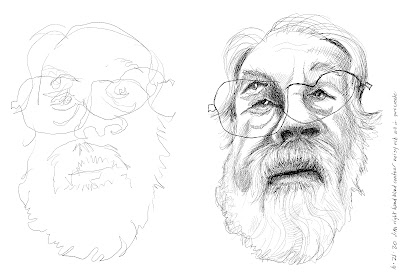 |
| A piece of tracing paper with blind contour drawings. These sketches go into a box to possibly be used in collage later. None are considered finished at this point. They will be torn away from the main sheet and used individually. It's a low pressure way to work. |
There are a number of ways that artists do blind contour drawings. In general the purpose is to strengthen observational and drawing skills. Most artists don't consider the final drawings to be a finished, presentable product. I find it a very useful way to generate sketches that are quirky. I consider some of them finished drawings that may end up in my collages. It's also a way for me to break away from my inclination to draw realistically, which drives me nuts.
I think this is the method that most art teachers use:
(This would likely be using a large sheet of paper.)
- Position yourself so you can see the subject, but not your paper.
- Fix your eye on an edge in the subject.
- Draw a continuous line on your paper, don't look at the drawing. Slowly follow the edge or contour with your eyes and the tool.
- Imagine that the drawing tool is touching the subject.
- Sometimes a timer is set.
There is no reason why you have to follow these “rules.”
My favorite method is to draw fairly fast. My drawing are small, between 3 and 6 inches high. They usually take about two minutes for the blind contour drawing. I often draw an area - an eye and the nose for example - and then lift my pen and start the second eye somewhere else. This can create interesting disjunctions. If I have done five or six drawings without looking at the paper when I lift the pen, and I don’t like any of them, then I would probably look at the paper to move my pen. I don't try to get it in the perfect spot, just in the ballpark. If I’m not looking, eye glasses can be split into pieces that may not look good so I usually draw them all in one line. After I have five to ten quick drawings, I add hatching to my favorites while looking at the subject and the drawing. I always feel free to enhance areas I like - like the eyes. Hatching in general adds volume and character. It also sometimes adds to the oddness of the drawing.
 |
| Blind contour drawing done on iPad with Procreate. I lost track of the eyes so there is an extra. Another layer was used to add hatching while looking at the photo. |
Possible variations:
- Use non-dominant hand.
- Or switch hands mid-drawing.
- Lift the drawing tool, don’t look at the paper to place it again.
- Or lift the tool, look at my paper to place it again but immediately look away.
- Draw fast.
- Draw very slow.
- Make hatching or scribbling marks as I do the blind part of the drawing. They have a different quality than the more deliberate ones I usually make while looking.
 |
| Feel-draw sketch, hatching added in ears, around nose and mouth while looking. |
Another closely related drawing method is what I call the feel-draw. I saw this in a drawing technique book, but can't find it now. I feel my face and draw what I feel. Ups and downs, bumps, etc. It's another way to get an interesting drawing with distortions. The variations apply here too. I like the effect of doing some blind hatching or scribbling to mark the lower areas like ear holes. So far these haven't made it into collages, they seem too weird. But as I say that I realize I need to use them.
 |
| Hands can be very interesting using blind contour methods. |
 |
| Working in Procreate on my iPad, I have a black layer behind the transparent layer I'm drawing on. |
When drawing on an ipad, I put a layer under the layer I'm drawing on that is the same color as my drawing tool. When I am drawing with a black pen, I draw on the top transparent layer. There is a layer below that is also black. That black layer won't be turned off until the blind part of the drawing is complete. I sometimes use a third layer to add the hatching.
 |
| Another group of drawings on tracing paper. I probably won't use most of these. I only like one right now. |





No comments:
Post a Comment